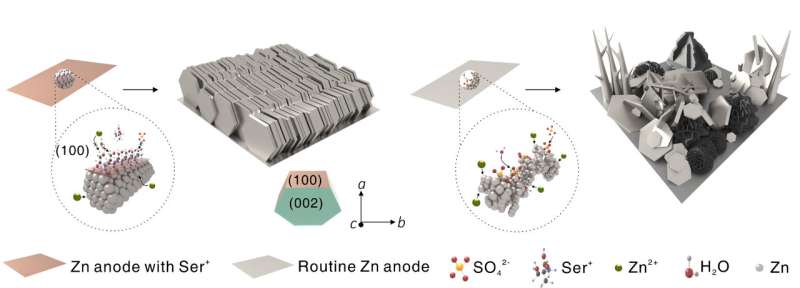The schematic illustration of Zn plating behavior with (left) and without (right) Ser additive. Credit: Li Zhaoqian
Researchers led by Prof. Hu Linhua from the Hefei Institutes of Physical Science of the Chinese Academy of Science found that the addition of serine cations (Ser+, C3H8NO3) in the electrolyte of aqueous zinc-ion battery would lead to the growth of the preferred Zn (100) texture, which could effectively inhibit the Zn dendrite growth and improve the reversibility and cyclability of batteries.
The study was published in Advanced Energy Materials.
Aqueous zinc-ion batteries (AZIBs) have attracted wide attention due to their safety, reliability, environmental friendliness, and cost effectiveness. The severe Zn dendrite growth often causes poor reversibility and has become the major obstacle to the widespread commercialization of AZIBs.
The high surface energy (100) facet promotes the nucleation and deposition along the [100] direction into "tip effect" active sites. Higher activity facet is often prone to induce side reactions that would seriously degrade the Zn anode and the battery stability. Therefore, inhibiting the rampant [100] direction growth is a simple and effective way to inhibit the dendrites and side reactions.
In this study, the researchers carried out a (100) facet termination engineering strategy using serine (Ser, C3H7NO3) as an interface structure conditioner in ZnSO4 system. The adsorption of serine cations induces the growth of Zn (100) texture and inhibits the harmful side reactions.
According to the researchers, the Zn//Cu batteries with modified electrolyte achieved an average Coulomb efficiency of about 99.8% at the rate of 5 mA cm-2 and 5 mAh cm-2 for plating/stripping cycles, and the Zn//Zn-symmetric batteries exhibited cycling performance of more than 800 hours.
In particular, the Zn//V2O5 full battery delivers high specific capacity of 345.1 mAh g-1 with a capacity retention of 74.1% over 2,000 cycles at 5 A g-1.
In addition, the assembled pouch battery also has good stability, demonstrating the practical feasibility of Ser/ZnSO4 electrolyte.
This study tailors the migration behavior of Zn2+ at the (100)-facet by adsorbing ions, providing a promising strategy to achieve the dominant texture of zinc anode at the ion level, and is expected to be applied to other metal anodes with poor stability and reversibility.
More information: Yifan Wang et al, Facet‐Termination Promoted Uniform Zn (100) Deposition for High‐Stable Zinc‐Ion Batteries, Advanced Energy Materials (2023). DOI: 10.1002/aenm.202301517
Journal information: Advanced Energy Materials
Provided by Chinese Academy of Sciences
























